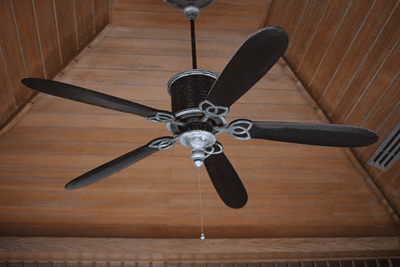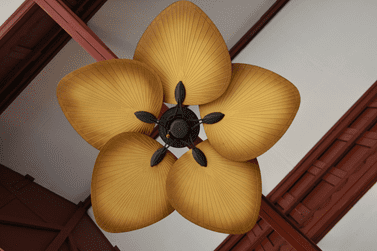Last Updated on April 2, 2024 by teamobn
Ceiling fans are more than just decorative fixtures hanging from your ceiling; they are a testament to functionality meeting style in the modern home. Beyond their ability to complement your decor, these fans play a crucial role in maintaining comfort and energy efficiency throughout the seasons.
Finding the perfect ceiling fan for your room goes beyond just picking out a style that suits your taste. It delves into the science of air movement and the art of interior design, balancing aesthetics with efficiency. Ceiling fans come in an astonishing range of sizes, from the compact 29-inch models for snug spaces to grand 99-inch fans designed for vast open areas.
This guide will equip you with the knowledge to navigate the complexities of ceiling fan sizes, understand the significance of their sweep, and make an informed choice based on the square footage and height of your room.

Ceiling Fan Sizes and What They Mean
When shopping for a ceiling fan, the available sizes can be impressive and overwhelming. The size of a ceiling fan is a critical factor affecting the fan’s efficiency in cooling or warming a room and its aesthetic fit within the space. Understanding the dimensions and what they signify can help you choose to perfectly balance function and style. This section breaks down the essentials of ceiling fan sizes, providing a clear pathway to selecting the ideal fan for your needs.
Understanding Fan Sweep
The term “fan sweep” refers to the diameter of the circle that the blades create as they rotate. It’s a crucial measurement determining the fan’s coverage area – essentially, how much air it can move. For fans with an even number of blades, the sweep is the distance from the tip of one blade to the tip of the opposite blade. In fans with an odd number of blades, the sweep is measured from the tip of one blade to the center of the fan and then doubled. This measurement is typically provided in inches, guiding you in understanding the scale of the fan relative to your room size.
Choosing the Right Size
The sweep of ceiling fans can start as small as 29 inches and extend up to 60 inches or more, catering to a range of room sizes and cooling needs. Here’s how to choose based on room dimensions:
- Small Rooms: For rooms less than 75 square feet, like small bedrooms or home offices, opt for a fan with a sweep of 36 inches or less.
- Medium Rooms: For spaces ranging from 75 to 144 square feet, such as standard bedrooms and dining rooms, a fan with a sweep between 36 to 42 inches is ideal.
- Large Rooms: Living rooms and larger spaces, more than 144 square feet, will require a fan with a sweep of 50 inches or more for effective air movement.
Consider installing multiple smaller fans in exceptionally large or open-plan areas to ensure even air distribution rather than a single large fan. This approach can offer a more tailored cooling strategy and often better complements the room’s aesthetic and functional zones.
Factoring in Room Configuration
Room configuration can also influence the size of the fan you need. High ceilings might benefit from larger fans or those with longer downrods to bring the blades closer to the living space. Conversely, rooms with low ceilings might require flush-mount fans to maintain safe clearance levels. Odd-shaped rooms or those with obstructions might need smaller fans or multiple units to achieve the desired airflow without interference.
Selecting the right size ceiling fan is about more than just matching the fan to your room’s square footage; it’s about considering the unique characteristics of your space to enhance comfort, efficiency, and style. With a clear understanding of fan sizes and their meaning, you’re well-equipped to make an informed decision that will bring years of pleasant, breezy comfort to your home.

Energy Efficiency and Ceiling Fans
In today’s eco-conscious world, energy efficiency isn’t just a buzzword—it’s a crucial criterion for selecting appliances, ceiling fans included. You’ll enjoy a cooled room and a low electricity bill if you factor in energy efficiency when looking for a ceiling fan. But not all fans are created equal in terms of efficiency. This section explores how to identify and select ceiling fans that promise optimal energy efficiency, ensuring you make a choice that benefits both your wallet and the planet.
Efficiency Ratings and Features
When embarking on the quest for an energy-efficient ceiling fan, the Energy Star rating is your beacon, guiding you to models that embody efficiency and environmental stewardship. This prestigious certification is not handed out lightly; it is the result of rigorous testing and evaluation by the U.S. Environmental Protection Agency (EPA).
Ceiling fans that bear this mark have surpassed baseline efficiency standards, operating on average 20% more efficiently than their non-certified counterparts. This leap in efficiency stems from innovations in motor and blade engineering, designed to move air more effectively while drawing less power.
But the journey to energy efficiency doesn’t end with the Energy Star emblem. Delve deeper, and you’ll discover features that further enhance a fan’s performance and reduce its energy footprint. Variable speed settings stand out as a pivotal tool in this quest.
They empower you to adjust the airflow to your precise comfort level, avoiding the energy waste associated with running a fan at full tilt when a gentle breeze would suffice. This customization not only conserves energy but also extends the fan’s lifespan by reducing wear on the motor.
The Role of Size and Installation
The efficiency of a ceiling fan is also influenced by its size and installation location. A fan that’s too small for a room will have to work harder, using more energy to circulate air effectively. Conversely, a fan that’s too large can consume unnecessary power. Thus, matching the fan size to the room’s square footage, as outlined in the previous section, is crucial for energy efficiency.
Proper installation plays a role as well. Ensure the fan is mounted at the optimal height—usually 8 to 9 feet from the floor—to maximize air movement without overworking the motor. Fans installed too close to the ceiling or too high can’t circulate air efficiently, leading to wasted energy.
Utilizing Fans for Year-Round Energy Savings
Ceiling fans can contribute to energy savings throughout the year. In summer, using a fan can make you feel up to 8 degrees cooler, allowing you to set your air conditioning thermostat higher without compromising on comfort.
In winter, reversing the fan’s direction to clockwise helps circulate warm air trapped at the ceiling, evenly distributing heat throughout the room. This simple adjustment can lower heating costs by redistributing warm air more effectively, reducing the need for additional heating.
Understanding and leveraging the energy efficiency of ceiling fans can transform how you cool and heat your home. By selecting the right fan and using it wisely, you can enjoy a comfortable indoor environment while minimizing your energy consumption and environmental impact. This not only leads to immediate cost savings but also contributes to a more sustainable lifestyle.

Ceiling Fan Design and Aesthetics:
Selecting the right ceiling fan for your space transcends mere practicality; it’s an artistic decision that fuses functionality with aesthetic allure. The array of designs available in today’s market means there’s a ceiling fan to complement every interior design ethos, from the starkly modern to the comfortably traditional.
This exploration into the interplay between ceiling fan design and room aesthetics uncovers how a thoughtfully chosen fan can elevate your space’s ambiance and express your style.
Harmonizing with Your Interior Theme
Choosing a ceiling fan is akin to picking out a piece of art; it should resonate with the room’s existing decor and reflect the overall theme you aim to achieve. For spaces adorned in a contemporary style, fans with a minimalist design featuring fewer blades and simple colors can subtly enhance the modern vibe without dominating the decor.
Conversely, rooms with a penchant for the traditional or rustic can benefit from ceiling fans that sport wooden blades and classic detailing, enriching the space’s warmth and inviting nature.
Elevating Your Space with a Bold Statement
The market offers designs that dare to stand out for those looking to transform their ceiling fan into a centerpiece rather than a mere accessory. Fans boasting unique blade designs or eye-catching lighting fixtures can become the heart of a room, drawing eyes and compliments alike.
Utilizing color can also breathe life into a room; a ceiling fan painted in a bold shade or decorated with patterned blades can infuse energy into a monochrome setting or accentuate the room’s color scheme.
The Role of Integrated Lighting
Fusing lighting with fan design offers a dual benefit, serving both functional and aesthetic purposes. The choice of lighting can dramatically affect the room’s atmosphere, from bright and inviting to soft and serene.
Opting for a fan with adjustable light settings allows you to tailor the ambiance to suit any occasion, whether illuminating a social gathering or creating a tranquil haven for relaxation.
The Significance of Materials
The materials chosen for a fan’s construction are pivotal in its visual impact and durability. Whether it’s the natural elegance of wood, the sleek appeal of metal, or the versatility of plastic, each material brings flavor to the design table. Selecting the right material ensures your ceiling fan matches your room’s aesthetic nuances and contributes to the space’s tactile experience.
In the quest for the perfect ceiling fan, the convergence of design and utility emerges as a theme of paramount importance. It’s about finding a piece that speaks to your aesthetic sensibilities while fulfilling its purpose gracefully.
Conclusion
Selecting the ideal ceiling fan for your space requires careful consideration of size, efficiency, and style. It’s a balance that ensures your fan complements the room’s aesthetics and optimizes airflow for year-round comfort. With the right research and understanding, you can transform a simple necessity into a statement piece that elevates your home’s functionality and beauty.
We have more guides on cooling your home. Check out our posts on practical methods to cooling your home!








